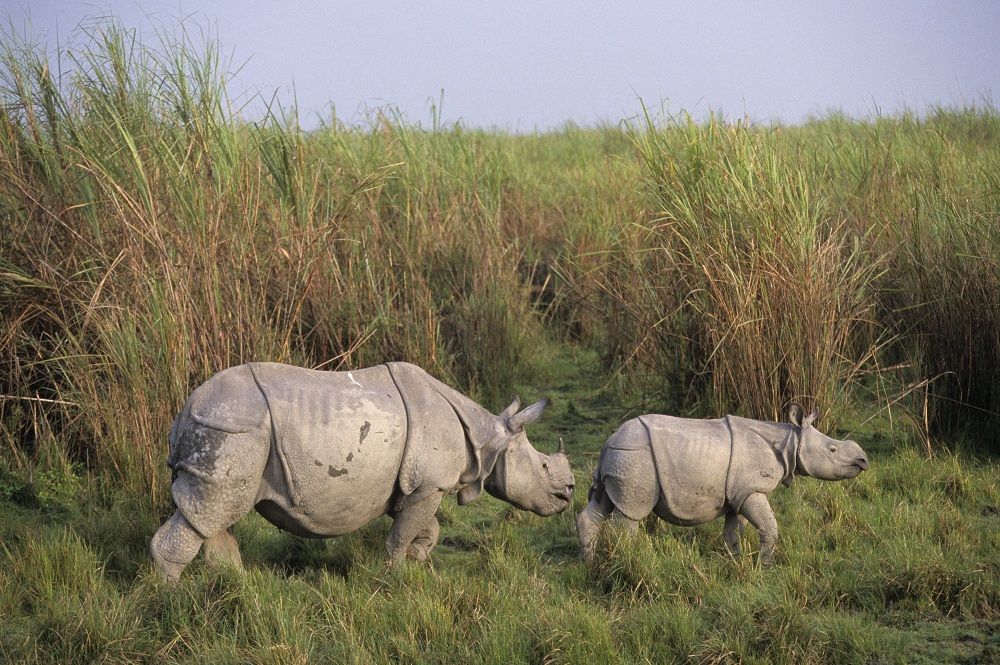In a year when many of us have been unable to see or hug our grandparents in a bid to keep them safe, it’s strange to think that because of their plight, young calves rarely get to meet theirs. But thanks to your support and the vision of a group of conservationists, the next generation of India’s Greater one-horned rhinos are making a comeback.
The history of the Greater one-horned rhino
The Greater one-horned rhino population once spread across Asia but, due to hunting and habitat loss, by the early 1900s, numbers had dwindled to fewer than 200. Fortunately, thanks to strict protections put in place by the Indian and Nepalese authorities, population numbers recovered to around 2,500 animals by 2005.
By this point, however, large areas of habitat had been lost to development, fragmenting the species’ range. In Assam, the species’ stronghold, rhinos were only found in three protected areas: Kaziranga National Park, Pobitora Wildlife Sanctuary and Orang National Park. Yet the largest of these, Kaziranga, was almost at capacity. Additionally, with the rhinos concentrated in just three areas, the risk of a disease or a natural disaster decimating the population was high. For the species to thrive, more habitat had to be secured.
Achieving the vision: rhinos thriving across Assam
In 2005, conservationists, alongside the Bodoland Territorial Council and the Government of Assam, developed a long-term, collaborative strategy to manage the species. Their vision was ambitious; to build a 3,000-strong wild population of Greater one-horned rhinos by 2020, spread across seven sites in the State of Assam. And so, the “Indian Rhino Vision 2020” (IRV2020) was born.
The goal was to reduce poaching and grow the population of Greater one-horned rhinos in Assam. With Kaziranga and Pobitora’s burgeoning rhino populations leading to overcrowding, project partners began moving rhinos to other protected areas where they could successfully breed, increasing their distribution across Assam.
Three generations roam Manas National Park once more
IRV2020 partners and community leaders spent years working on habitat improvements and critical security measures before rhinos could be translocated.
Finally, in 2007, Ganga, a female rhino, became the first to arrive in Manas National Park, two years after rhinos had been wiped out of the area. In 2008, she was joined by 17 others. Despite challenges posed by poachers, Ganga gave birth to a female calf in 2013. Four years later, the calf reached maturity and gave birth to her own calf, meaning that Manas is now home to three generations of Greater one-horned rhinos.
At the end of February 2020, a seventh IRV2020 translocation operation brought two female rhinos from Kaziranga to Manas National Park, and the final rhino translocation saw an adult male and female moved from Pobitora to Manas in early 2021.
Moving forward
Despite the devastating news that two Greater one-horned rhinos were poached in Kaziranga National Park during 2020 – ending 13 months of zero poaching incidents – poaching has reduced by an amazing 86% in the region (decreasing from 22 incidents in 2016).
Thanks to IRV2020, there are significantly more Greater one-horned rhinos today than there were in 2005 and, the population is growing. While the 2020 census was not carried out due to the pandemic, it is believed the initial target of 3,000 rhinos has likely been met. The target to protect seven areas may not have been achieved, but Assam’s rhino population is in a much stronger state, knowledge has been gained, and the team will be looking at what can be accomplished over the next decade.
On behalf of the IRV2020 programme team, Save the Rhino International would like to say a massive thank you to all of you, and Rotterdam Zoo and Parc Animalier de Branfere in particular, for your continued support. Thanks to your generous donations, the IRV2020 programme has already taken huge steps to ensure Greater one-horned rhinos will live to see their grandchildren grow up.








